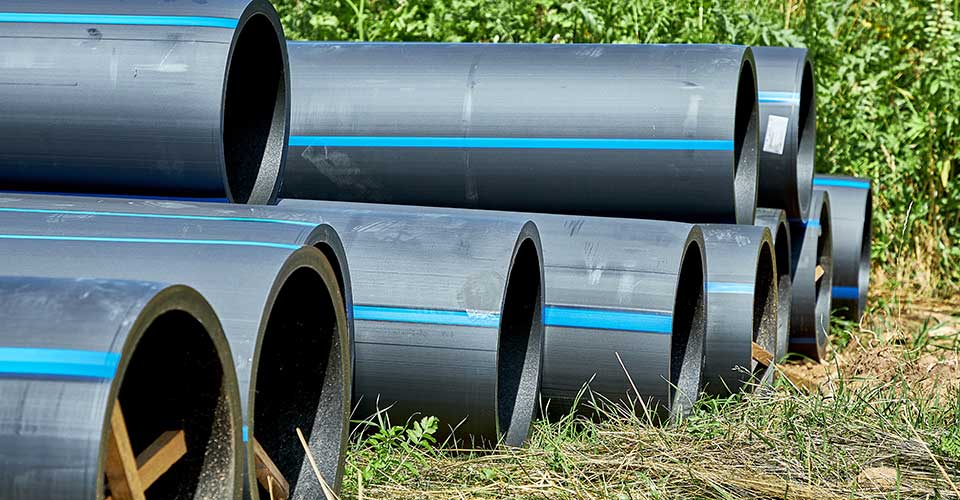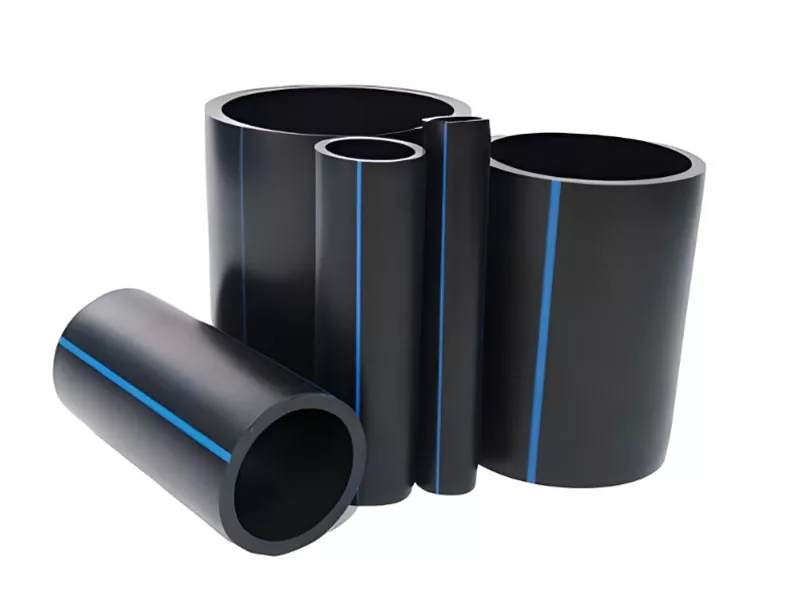Strengths of Choosing custom hdpe pipe manufacturing Midland TX for Unique Requirements
Check Out the Manufacturing Process Behind High-Quality HDPE Pipe and Its Applications
The production procedure of premium HDPE pipes is intricate and methodical. It starts with the option of resources that improve efficiency. Following this, ethylene undergoes polymerization to develop material, which is after that formed through extrusion. Quality control is extremely important, making sure that the final product satisfies strict standards. Nonetheless, the journey of HDPE pipes doesn't finish with manufacturing. Their applications across different markets disclose a more comprehensive significance worth checking out.
Understanding HDPE: Qualities and Advantages

High-density polyethylene (HDPE) is a functional thermoplastic recognized for its resilience and resistance to various ecological elements. This material shows superb tensile toughness, making it suitable for requiring applications. Its low-density structure adds to a lightweight product, assisting in ease of dealing with and setup. HDPE likewise showcases amazing resistance to chemicals, which decreases deterioration when exposed to harsh materials.
The material's reduced moisture absorption better improves its longevity, making it perfect for usage in pipes and tank. Furthermore, HDPE is resistant to ultraviolet (UV) radiation, making sure that items maintain their stability also when exposed to sunlight. Additionally, its flexibility permits for the development of elaborate shapes without compromising stamina. The environmentally friendly nature of HDPE, frequently obtained from recycled products, includes to its appeal, advertising sustainable practices in production. Overall, these residential properties and benefits make HDPE a recommended choice for different commercial and customer applications.
Raw Material Option for HDPE Production
The choice of basic materials for HDPE manufacturing is necessary to validate the last item meets the wanted requirements and top quality standards. High-density polyethylene (HDPE) is primarily produced from polymerized ethylene, acquired from nonrenewable fuel sources such as gas or petroleum. The top quality of these feedstocks considerably affects the mechanical and thermal homes of the final HDPE.
Ingredients additionally play a substantial duty in improving HDPE's efficiency, consisting of anti-oxidants, UV stabilizers, and colorants, which improve durability and resistance to environmental aspects. The choice process should take into consideration not just the chemical structure of the raw materials however likewise their processing qualities to guarantee efficient manufacturing.
The sourcing of raw products need to focus on sustainability and conformity with ecological guidelines, as liable practices are crucial in today's market. Inevitably, careful raw product selection lays the structure for producing high-quality HDPE pipes ideal for varied applications.
The Extrusion Process: Shaping HDPE Pipeline
The extrusion process plays an important role fit HDPE pipelines, beginning with careful material prep work techniques that guarantee excellent circulation and uniformity. Similarly essential is the design of the die, which directly influences the final measurements and surface area top quality of the pipe. With each other, these elements add considerably to the effectiveness and top quality of HDPE pipe manufacturing.
Product Prep Work Techniques
Efficient manufacturing of HDPE pipelines begins with thorough material preparation strategies, specifically the extrusion procedure. Throughout this phase, high-density polyethylene resin is very first dried to remove wetness, making sure ideal circulation qualities. The material is then fed right into the extruder, where it undertakes heating and melting, transforming into a viscous state. This heating process is meticulously regulated to preserve the material's stability and efficiency. The molten HDPE is forced with a die, shaping it into a continual pipeline kind. Appropriate temperature administration throughout extrusion is essential, as it straight impacts the material's properties and the final product quality. When shaped, the HDPE pipe is cooled down and cut to specified sizes, all set for succeeding processing and applications.
Die Design Significance
Precision in die design plays an important role in the extrusion process of HDPE pipes. The die serves as the final shaping device, directly influencing the pipe's dimensions, wall surface thickness, and surface coating. A well-designed die assurances uniform material flow, reducing flaws such as irregularities and weak points. The geometry of the die need to be optimized to fit the certain residential or commercial properties of HDPE, including its thickness and thermal actions during extrusion. In addition, the cooling price of the material as it passes through the die can substantially affect the pipeline's structural stability. Investing in advanced die technology is vital for manufacturers intending to produce high-quality HDPE pipelines that fulfill market requirements and customer expectations.
Quality Assurance Actions in HDPE Production
Although different elements influence the quality of HDPE pipeline manufacturing, effective quality assurance actions are essential to ensure consistency and dependability in the end product. Secret quality assurance practices consist of extensive material examination, verifying that the raw polyethylene meets well established criteria for pureness and thickness. During the extrusion procedure, criteria such as temperature level, pressure, and cooling time are carefully kept an eye on to keep dimensional index precision and structural honesty
Additionally, post-production testing is crucial; manufacturers typically perform hydrostatic tests to analyze the pipe's strength and resistance to pressure. Aesthetic assessments for surface issues additionally boost quality control. Qualification from relevant requirements organizations, like ASTM or ISO, supplies an additional layer of credibility. By implementing these thorough quality assurance steps, producers can decrease problems, improve performance, and make certain that the HDPE pipelines satisfy the particular needs of different applications, inevitably resulting in customer plastic pipe end caps satisfaction and trust in the item.
Applications of HDPE Pipeline Across Industries
HDPE pipelines are made use of across various sectors because of their resilience and adaptability. In water circulation systems, they ensure effective shipment, while in wastewater administration, they give reliable options for waste transport. Additionally, farming watering networks benefit from HDPE's resistance to corrosion and flexibility, making it a perfect option for contemporary farming methods.

Water Circulation Systems
A considerable number of sectors rely upon high-density polyethylene (HDPE) pipelines for efficient water distribution systems. Recognized for their sturdiness and resistance to corrosion, HDPE pipes are commonly made use of in municipal water system networks, farming watering, and commercial applications. Their light-weight nature helps with simple handling and installation, reducing labor expenses and time. Additionally, HDPE pipes can fit numerous pressure degrees, making them suitable for both low and high-pressure systems. American Plastics HDPE Pipe Manufacturing. The adaptability of the product enables smooth integration into existing facilities, reducing the requirement for extensive excavation. Furthermore, HDPE's resistance to chemical seeping guarantees that the water supplied remains risk-free and clean, making it an ideal option for maintaining the quality of potable water across various fields
Wastewater Administration Solutions
Reliable water distribution systems also lead the way for innovative wastewater management options, where high-density polyethylene (HDPE) pipes play a significant role. Distinguished for their longevity and resistance to rust, HDPE pipelines are perfect for moving wastewater in various settings. Their flexibility enables simple setup in complex atmospheres, decreasing the need a knockout post for extensive excavation. In addition, HDPE's smooth indoor surface reduces rubbing, enhancing flow prices and effectiveness. These pipelines are also resistant to chemical leaching, making certain that pollutants do not jeopardize the surrounding setting. Industries, districts, and therapy centers progressively depend on HDPE pipes for their dependability and durability, making them a recommended selection for modern-day wastewater monitoring systems. This flexibility underscores the important relevance of HDPE pipes across various applications.
Agricultural Irrigation Networks
Agricultural watering networks benefit significantly from the usage of high-density polyethylene (HDPE) pipes, which provide efficient and trusted water delivery to plants. HDPE pipelines are light-weight, making them easy to carry and mount, while their adaptability allows for numerous arrangements in diverse terrains. These pipes show superb resistance to deterioration, chemicals, and UV radiation, guaranteeing longevity in rough agricultural environments. Additionally, their smooth indoor surface lessens rubbing loss, enhancing water circulation and minimizing power expenses connected with pumping. The durability of HDPE pipelines, typically surpassing 50 years, contributes to decrease upkeep and replacement expenditures. Farmers increasingly count on HDPE pipes to improve watering performance and advertise lasting agricultural practices, inevitably leading to improved plant yields and resource conservation.

Future Trends in HDPE Pipe Innovation
As the demand for sustainable and effective infrastructure grows, developments in HDPE pipe technology are poised to change numerous markets. Arising trends consist of the combination of smart modern technologies, such as sensing units and IoT capabilities, which help with real-time tracking of pipeline conditions, minimizing upkeep expenses and avoiding leaks. Additionally, the growth of innovative production strategies, such as 3D printing, is allowing the production of complex, tailored pipe styles that satisfy details task demands.
In addition, the focus on recycling and circular economy techniques is driving the technology of HDPE pipelines made from recycled products, improving sustainability. Improved jointing methods, such as electro-fusion and mechanical fittings, are also improving installation effectiveness and reliability. The expanding focus on environmental regulations is pressing makers to adopt greener manufacturing processes, making sure that HDPE pipes not only meet market standards yet additionally promote a more lasting future for framework growth.
Frequently Asked Questions
How Does HDPE Compare to Other Plastic Products?
HDPE exceeds lots of other plastic materials pertaining to resilience, chemical resistance, and flexibility. Its low density and high tensile stamina make it excellent for different applications, frequently exceeding alternatives in both efficiency and long life.
What Are the Ecological Influences of HDPE Production?
The ecological effects of HDPE manufacturing consist of greenhouse gas exhausts, power intake, and possible contamination from manufacturing processes. In addition, improper disposal can bring about soil and water contamination, increasing issues regarding long-term environmental impacts.
Can HDPE Pipeline Be Recycled?
Yes, HDPE pipes can be reused. Numerous facilities accept made use of HDPE for processing, changing it into brand-new items. This reusing contributes to sustainability initiatives, minimizing plastic waste while saving sources and power in the manufacturing cycle.
What Is the Life Expectancy of HDPE Piping?

Exactly How Do Temperature Variations Impact HDPE Pipe Performance?
Temperature variations significantly impact HDPE pipe efficiency, affecting versatility and toughness. High temperatures can bring about softening, while reduced temperatures might trigger brittleness, ultimately influencing the pipeline's longevity and suitability for various applications in diverse settings.